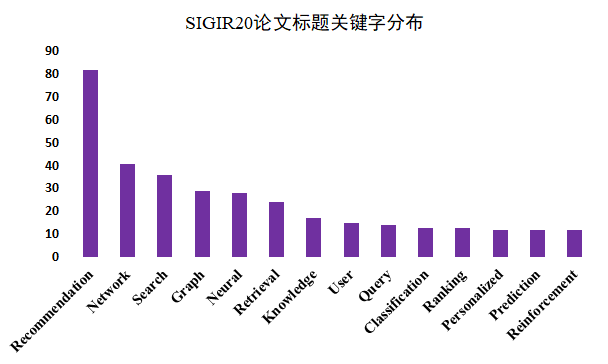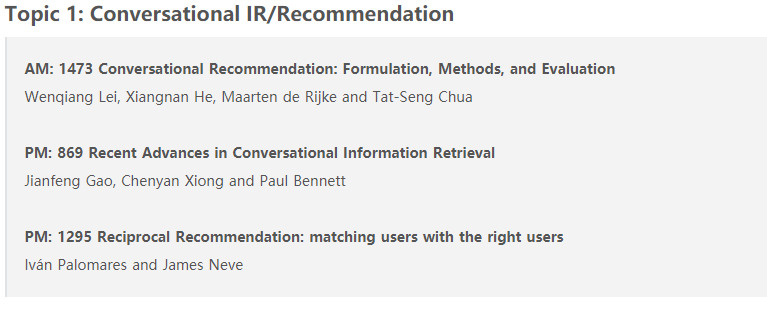SIGIR2020推荐系统论文聚焦

目录
-
前言 -
推荐论文列表
前言
第43届国际信息检索研究和发展大会(SIGIR)将于2020年7月25-30日在美丽的中国西安举行。此次大会共收到了555篇长文投稿,录用147篇,长文录取率26.4%;共收到了507篇短文投稿,录用153篇,短文录取率30%。
正因为推荐与搜索是解决信息过载的两种有效途径,因此虽然是关于检索的会议,但通过下图可以看出推荐(Recommendation)占据了很大比例,与搜索(Search+Retrieval)不相上下。另外,图与网络(Graph/Network)数据成为研究的主要对象,毕竟许多待研究的对象都可以表示为图。值得注意的是,神经网络(Neural)仍然排在前列;融合知识(Knowledge)的搜索/推荐系统也被许多研究者研究。除此之外,强化学习也出现在了排行榜中,可见利用强化学习的思想来迭代优化搜索/推荐逐渐成为流行。

另外,还注意到今年SIGIR开办了一场关于对话推荐/检索的Tutorial,感兴趣的小伙伴可以多多关注。想提前了解对话推荐(Conversational RS,CRS)的朋友,可以公众号后台回复【CRS】获取对话推荐系统最新综述。

推荐论文列表
本次只对大会的长文(Full Papers)进行梳理,因此共整理出63篇关于推荐系统的论文。为了方便查看与了解,我们主要将其分为了以下几类:Sequential RS,Graph-based RS,Cold-start in RS,Efficient RS,Knowledge-aware RS,Robust RS,Group RS,Conversational RS,RL for RS,Cross-domain RS,Explainable RS,POI RS。另外,对于有一些不包含在以上类别的文章,我们统一归为了Others。当然,以上分类仁者见仁,智者见智,目的是给大家一个相对清晰的结构。具体的各个类别所包含的论文数见下表。
| 分类 | 数量 |
|---|---|
| Sequential RS | 8 |
| Graph-based RS | 6 |
| Robust RS |
6 |
| Efficient RS | 5 |
| Knowledge-aware RS | 5 |
| Cold-start in RS |
4 |
| Group RS |
4 |
| Conversational RS |
4 |
| RL for RS |
3 |
| Cross-domain RS |
2 |
| Explainable RS |
2 |
| POI RS |
1 |
| Others |
13 |
可见,序列化推荐的文章占比较大;随后是基于图的推荐、鲁棒的推荐系统;其次是提升推荐效率的文章、基于知识的推荐以及解决冷启动问题的推荐文章、组推荐、对话推荐系统;最后是强化学习推荐、跨域推荐、可解释推荐以及兴趣点推荐。当然其他类别中也包含了许多有意思的研究,比如消除推荐偏置(Bias)的文章、分布式训练推荐系统的文章以及如何retrain推荐系统的文章等。
接下来是分类好的推荐论文列表,大家可以根据自己的研究子方向进行精读。
Sequential RS
Incorporating User Micro-behaviors and Item Knowledge into Multi-task Learning for Session-based Recommendation.
-
GAG: Global Attributed Graph Neural Network for Streaming Session-based Recommendation.
-
Sequential Recommendation with Self-attentive Multi-adversarial Network.
-
A General Network Compression Framework for Sequential Recommender Systems.
-
Next-item Recommendation with Sequential Hypergraphs.
-
KERL: A Knowledge-Guided Reinforcement Learning Model for Sequential Recommendation.
-
Time Matters: Sequential Recommendation with Complex Temporal Information.
-
Modeling Personalized Item Frequency Information for Next-basket Recommendation.
Graph-based RS
-
Learning to Transfer Graph Embeddings for Inductive Graph based Recommendation.
-
Joint Item Recommendation and Attribute Inference: An Adaptive Graph Convolutional Network Approach.
-
Multi-behavior Recommendation with Graph Convolution Networks.
-
Hierarchical Fashion Graph Network for Personalised Outfit Recommendation.
-
Neighbor Interaction Aware Graph Convolution Networks for Recommendation.
-
Disentangled Representations for Graph-based Collaborative Filtering.
Cold-start RS
-
Content-aware Neural Hashing for Cold-start Recommendation.
-
Recommending Podcasts for Cold-Start Users Based on Music Listening and Taste.
-
Recommendation for New Users and New Items via Randomized Training and Mixture-of-Experts Transformation.
-
AR-CF: Augmenting Virtual Users and Items in Collaborative Filtering for Addressing Cold-Start Problems.
Efficient RS
-
Lightening Graph Convolution Network for Recommendation.
-
A General Knowledge Distillation Framework for Counterfactual Recommendation via Uniform Data.
-
Beyond User Embedding Matrix: Learning to Hash for Modeling Large-Scale Users in Recommendation.
-
Parameter-Efficient Transfer from Sequential Behaviors for User Modeling and Recommendation.
-
Online Collective Matrix Factorization Hashing for Large-Scale Cross-Media Retrieval.
Knowledge-aware RS
-
Jointly Non-Sampling Learning for Knowledge Graph Enhanced Recommendation.
-
Fairness-Aware Explainable Recommendation over Knowledge Graphs.
-
Attentional Graph Convolutional Networks for Knowledge Concept Recommendation in MOOCs in a Heterogeneous View.
-
Make It a CHORUS: Context- and Knowledge-aware Item Modeling for Recommendation.
-
CKAN: Collaborative Knowledge-aware Attentive Network for Recommender Systems.
Robust RS
-
How Dataset Characteristics Affect the Robustness of Collaborative Recommendation Models.
-
GCN-Based User Representation Learning for Unifying Robust Recommendation and Fraudster Identification.
-
How Dataset Characteristics Affect the Robustness of Collaborative Recommendation Models.
-
Certifiable Robustness to Discrete Adversarial Perturbations for Factorization Machines.
-
DPLCF: Differentially Private Local Collaborative Filtering.
-
Data Poisoning Attacks against Differentially Private Recommender Systems.
Group RS
-
GAME: Learning Graphical and Attentive Multi-view Embeddings for Occasional Group Recommendation.
-
GroupIM: A Mutual Information Maximizing Framework for Neural Group Recommendation.
-
Group-Aware Long- and Short-Term Graph Representation Learning for Sequential Group Recommendation.
-
Global Context Enhanced Graph Nerual Networks for Session-based Recommendation.
Conversational RS
-
Deep Critiquing for VAE-based Recommender Systems.
-
Interactive Recommender System via Knowledge Graph-enhanced Reinforcement Learning.
-
Towards Question-based Recommender Systems.
-
Neural Interactive Collaborative Filtering.
RL for RS
-
Self-Supervised Reinforcement Learning for Recommender Systems.
-
MaHRL: Multi-goals Abstraction based Deep Hierarchical Reinforcement Learning for Recommendations.
-
Leveraging Demonstrations for Reinforcement Recommendation Reasoning over Knowledge Graphs.
Cross-domain RS
-
Transfer Learning via Contextual Invariants for One-to-Many Cross-Domain Recommendation.
-
CATN: Cross-Domain Recommendation for Cold-Start Users via Aspect Transfer Network.
Explainable RS
-
Measuring Recommendation Explanation Quality: The Conflicting Goals of Explanations.
-
Try This Instead: Personalized and Interpretable Substitute Recommendation.
POI RS
-
HME: A Hyperbolic Metric Embedding Approach for Next-POI Recommendation.
Others
-
Learning Personalized Risk Preferences for Recommendation.
-
Octopus: Comprehensive and Elastic User Representation for the Generation of Recommendation Candidates.
-
Spatial Object Recommendation with Hints: When Spatial Granularity Matters.
-
Agreement and Disagreement between True and False-Positive Metrics in Recommender Systems Evaluation.
-
Distributed Equivalent Substitution Training for Large-Scale Recommender Systems.
-
The Impact of More Transparent Interfaces on Behavior in Personalized Recommendation.
-
MVIN: Learning multiview items for recommendation.
-
How to Retrain a Recommender System?
-
Measuring and Mitigating Item Under-Recommendation Bias in Personalized Ranking Systems.
-
BiANE: Bipartite Attributed Network Embedding.
-
ASiNE: Adversarial Signed Network Embedding.
-
Learning Dynamic Node Representations with Graph Neural Networks.
-
Asymmetric Tri-training for Debiasing Missing-Not-At-Random Explicit Feedback.
推荐阅读





